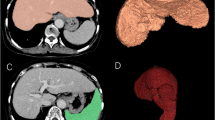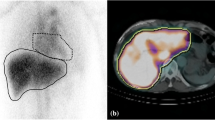Abstract
Objective: Liver regeneration after hepatectomy is correlated with liver fibrosis. Retrospectively, we compared three quantitative indices (HH15, LHL15 and LU15) of Technetium-99m-diethylenetriaminepentaacetic acid-galactosyl-human serum albumin (Tc-99m-GSA) liver scintigraphy with liver fibrosis; in particular, we compared the HH15 index and the rate of remnant liver regeneration.Methods: Fifty-three patients who had undergone hepatectomy were enrolled in this study. The non-neoplastic parts of their resected specimens were divided into 5 groups (F0-F4) according to the degree of liver fibrosis, as determined using the New Inuyama classification system: F0, no fibrosis (n=12); F1, portal fibrosis widening (n=12); F2, portal fibrosis widening with bridging fibrosis (n=14); F3, bridging fibrosis plus lobular distortion (n=7); F4, liver cirrhosis (n=8).Results: When the cases were divided into a no or mild fibrosis group (F0 and F1) and a moderate or severe fibrosis or cirrhosis group (F2, F3 and F4), all of the indices were significantly different between the two groups. In this analysis, the areas (Az) under the receiver operating characteristic (ROC) curves for the HH15 and LHL15 indices were very similar, while the Az for the LU15 index was smaller. An HH15 index equal to 0.52 was the most accurate, producing a 79.3% sensitivity and a 75.0% specificity rating. When 18 patients that had received a CT scan one month after hepatectomy were divided into 2 groups according to their HH15 value (group A, HH15 ≤0.52; group B, HH15>0.52), group A exhibited a better regeneration rate.Conclusion: Tc-99m-GSA scintigraphy is well correlated with liver fibrosis and may be useful for non-invasive, preoperative evaluations of liver fibrosis. The HH15 index, in particular, may be useful for predicting the rate of liver regeneration after hepatectomy.
Similar content being viewed by others
References
Pricer WE, Ashwell G. The binding of desialylated glycoproteins by plasma membranes of rat liver.J Biol Chem 1971; 246: 4825–4833.
Morell AG, Gregoriadis G, Scheinberg IH, Hickman J, Ashwell G. The role of sialic acid in determining the survival of glycoproteins in the circulation.J Biol Chem 1971; 246: 1461–1467.
Morell AG, Irvine RA, Sternlieb I, Scheinberg IH, Ashwell G. Physical and chemical studies on ceruloplasmin.J Biol Chem 1968; 243: 155–159.
Miyazaki S, Takasaki K, Yamamoto M, Tsugita M, Otsubo T. Liver regeneration and restoration of liver function after partial hepatectomy: the relation of fibrosis of the liver parenchyma.Hepatogastroenterology 1999; 46: 2919–2924.
Ogata T, Okuda K, Ueno T, Saito N, Aoyagi S. Serum hyaluronan as a predictor of hepatic regeneration after hepatectomy in humans.Eur J Clin Invest 1999; 29: 780–785.
Nagasue N, Yukaya H, Ogawa Y, Kohno H, Nakamura T. Human liver regeneration after major hepatic resection.Ann Surg 1987; 206: 30–39.
Yamanaka N, Okamoto E, Kawamura E, Kato T, Oriyama T, Fujimoto J, et al. Dynamics of normal and injured human liver regeneration after hepatectomy as assessed on the basis of computed tomography and liver function.Hepatology 1993; 18: 79–85.
Shimada M, Matsumata T, Adachi E, Itasaka H, Watiyama S, Sugimachi K. Estimation of degree of liver cirrhosis using a fibrosis score; a multivariate analysis of clinical parameters and resected specimens.Hepatogastroenterology 1994; 41: 177–180.
Kusaka K, Harihara Y, Torzilli G, Kubota K, Takayama T, Makuuchi M, et al. Objective evaluation of liver consistency to estimate hepatic fibrosis and functional reserve for hepatectomy.J Am Coll Surg 2000; 191: 47–53.
Gadano A, Hadengue A, Vachiery F, Moreau R, Sogni P, Soupison T, et al. Relationship between hepatic blood flow, liver tests, haemodynamic values and clinical characteristics in patients with chronic liver disease.J Gastroenterol Hepatol 1997; 12: 167–171.
Kwon A, Ha-Kawa SK, Uetsuji S, Kamiyama Y, Tanaka Y. Use of technetium 99m diethylenetriamine-pentaacetic acid-galactosyl-human serum albumin liver scintigraphy in the evaluation of preoperative and postoperative hepatic functional reserve for hepatectomy.Surgery 1995; 117: 429–434.
Koizumi K, Uchiyama G, Arai T, Ainoda T, Yoda Y. A new liver functional study using Tc-99m DTPA-galactosyl human serum albumin: Evaluation of the validity of several functional parameters.Ann Nucl Med 1992; 6: 83–87.
Ichida F, Tsuji T, Omata M, Ichida T, Inoue K, Kamimura T, et al. New Inuyama classification; new criteria for histological assessment of chronic hepatitis.Int Hepatol Commun 1996; 6: 112–119.
Desmet VJ, Gerber M, Hoofnagle JH, Manns M, Scheuer PJ. Classification of chronic hepatitis: diagnosis, grading and staging.Hepatology 1994; 19: 1513–1520.
Metz CE, Herman BA, Roe CA. Statistical comparison of two ROC-curve estimates obtained from partially-paired datasets.Med Decis Making 1998; 18: 110–121.
Kin Y, Nimura Y, Hayakawa N, Kamiya J, Kondo S, Nagino M, et al. Doppler analysis of hepatic blood flow predicts liver dysfunction after major hepatectomy.World J Surg 1994; 18: 143–149.
Miyazawa K, Shimomura T, Kitamura N. Activation of hepatocyte growth factor in the injured tissues is mediated by hepatocyte growth factor activator.J Biol Chem 1996; 271: 3615–3618.
Rigotti P, Peters JC, Tranberg K, Fischer JE. Effects of amino acid infusions on liver regeneration after partial hepatectomy in the rat.JPEN 1986; 10: 17–20.
Murawaki Y, Ikuta Y, Koda M, Kawasaki H. Serum type III procollagen peptide, type IV collagen 7S domain, central triple-helix of type IV collagen and tissue inhibitor of metalloproteinases in patients with chronic viral liver disease: relationship to liver histology.Hepatology 1994; 20: 780–787.
Imbert-Bismut F, Ratziu V, Pieroni L, Charlotte F, Benhamou Y, Poynard T. Biochemical markers of liver fibrosis in patients with hepatitis C virus infection: a prospective study.Lancet 2001; 357: 1069–1075.
Burgess JB, Baenziger JU, Brown WR. Abnormal surface distribution of the human asialoglycoprotein receptor in cirrhosis.Hepatology 1992; 15: 702–706.
Sawamura T, Nakada H, Hazama H, Shiozaki Y, Sameshima Y, Tashiro Y. Hyperasyaloglycoproteinemia in patients with chronic liver diseases and/or liver cell carcinoma.Gastroenterology 1984; 87: 1217–1221.
Sawamura T, Kawasato S, Shiozaki Y, Sameshima Y, Nakada H, Tashiro Y. Decrease of a hepatic binding protein specific for asialoglycoproteins with accumulation of serum asialoglycoproteins in galactosamine-treated rats.Gastroenterology 1981; 81: 527–533.
Kwon A, Ha-Kawa SK, Uetsuji S, Inoue T, Matsui Y, Kamiyama Y. Preoperative determination of the surgical procedure for hepatectomy using technetium-99m-galactosyl human serum albumin (99mTc-GSA) liver scintigraphy.Hepatology 1997; 25: 426–429.
Ha-Kawa SK, Tanaka Y. A quantitative model of technetium-99m-DTPA-galactosyl-HSA for the assessment of hepatic blood flow and hepatic binding receptor.J Nucl Med 1991; 32: 2233–2240.
Kudo M, Todo A, Ikekubo K, Hino M. Receptor index via hepatic asialoglycoprotein receptor imaging: correlation with chronic hepatocellular damage.Am J Gastroenterol 1992; 87: 865–870.
Knodell RG, Ishak KG, Black WC, Chen TS, Craig R, Kaplowitz N, et al. Formulation and application of a numerical scoring system for assessing histological activity in asymptomatic chronic active hepatitis.Hepatology 1981; 1: 431–435.
Tomiguchi S, Kira T, Oyama Y, Nabeshima M, Nakashima R, Tsuji A, et al. Correlation of Tc-99m GSA hepatic studies with biopsies in patients with chronic active hepatitis.Clin Nucl Med 1995; 20: 717–720.
Kira T, Tomiguchi S, Takahashi M, Yoshimatsu S, Sagara K, Kurano R. Correlation of99mTc-GSA hepatic scintigraphy with liver biopsies in patients with chronic active hepatitis type C.Radiat Med 1999; 17: 125–130.
Hwang E, Taki J, Shuke N, Nakajima K, Kinuya S, Konishi S, et al. Preoperative assessment of residual hepatic functional reserve using99mTc-DTPA-galactosyl-human serum albumin dynamic SPECT.J Nucl Med 1999; 40: 1644–1651.
Author information
Authors and Affiliations
Corresponding author
Rights and permissions
About this article
Cite this article
Iguchi, T., Sato, S., Kouno, Y. et al. Comparison of Tc-99m-GSA scintigraphy with hepatic fibrosis and regeneration in patients with hepatectomy. Ann Nucl Med 17, 227–233 (2003). https://doi.org/10.1007/BF02990026
Received:
Accepted:
Issue Date:
DOI: https://doi.org/10.1007/BF02990026




